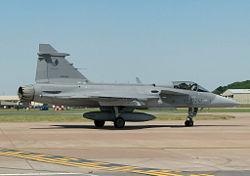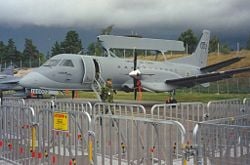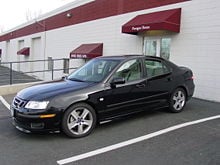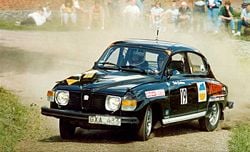Saab
SAAB AB is an aviation, defense, and car manufacturing company based in Sweden and founded in 1937, in Trollhättan. Its name was an acronym for "Svenska aeroplanaktiebolaget" (translates to Swedish Aeroplane Limited), thus written as "SAAB." In 1939, Saab merged with the Linköping based ASJA and the headquarters moved to Linköping. During changes in company ownership in the 1990s, the company name became SAAB AB.
Originally manufacturing airplanes, the company sought ways in which to diversify its business and in the late 1940s, started to manufacture Saab Automobiles, the reverse of the Rolls-Royce, Ltd. story which began with cars then expanded into a major builder of aircraft engines. The automobile division was based in Trollhättan. The first car was the Saab 92001 on June 10, 1947. The company soon developed a reputation for safe and reliable automobiles, with a notable competition history. Saab cars won many rallies in the 1960s, ceased competing in 1980, but recommenced in 2000. In the late 1950s, Saab ventured into the computer market with DataSAAB. In 1969. SAAB merged with the truck maker Scania-Vabis, and between 1969 and 1995, the company was called Saab-Scania AB. General Motors bought 51 percent of the automobile division Saab Automobile in 1990, and acquired the rest a decade later. The best known feature of Saab cars are their turbocharged engines, in addition to a reputation for precision engineering and reliability.
Ownership
Since 1998, the British aerospace company BAE Systems has been the largest shareholder in Saab following its acquisition of a 35 percent stake from Investor AB by its predecessor, British Aerospace. In January 2005, BAE reduced its shareholding to 20 percent, which it views as a long term interest. Investor AB also maintains a 20 percent share.
Aircraft
The main focus of aircraft production is fighter aircraft, with the recent JAS 39 Gripen as the main model. SAAB has been making airplanes since the 1930s, and the purely jet predecessors to the Gripen were the Tunnan, the Lansen, the Draken and the Viggen. The last civilian models made by SAAB were the Saab 340 and Saab 2000. Both were mid-range, turboprop-powered, passenger planes. The development and the manufacturing of these airplanes takes place in Linköping, Sweden.
In 1995, SAAB Military Aircraft and British Aerospace (now BAE Systems) formed the joint venture company, SAAB-BAe Gripen AB, with the goal of adapting, manufacturing, marketing and supporting Gripen internationally. This cooperation was extended in 2001, with the formation of Gripen International for the same purpose.
BAE designed an improved wing, which they then manufactured and are set to produce 45 percent of export airframes. SAAB Military Aircraft is responsible for the overall "aircraft system" including basic aircraft development and production, and testing and delivery.
- Saab 17 (bomber/dive-bomber)
- MFI-15 Safari
- Saab 18 (bomber)
- Saab 21 (push-prop)
- Saab 21R (jet)
- Saab 29 Tunnan
- Saab 32 Lansen
- Saab 35 Draken
- Saab 37 Viggen
- Saab 39 Gripen
- Saab 90 Scandia
- Saab 91 Safir
- Saab 105
- Saab 340 (A and B models)
- Saab 2000
Datasaab
The Datasaab company was a result partly of the need of heavy computational power for the aircraft development, partly of the science-fictional idea to make a computer that would be small enough to mount in an aeroplane as navigational equipment. During the 1960s, several successful and advanced systems were developed and sold to several European countries (used, for example, in banking). The aircraft computer (CK37) was achieved in 1971, in the Viggen. The now less successful company was sold off in 1975 to Sperry UNIVAC, while flight computer development was kept in SAAB.
Automobiles
Saab Automobile AB is an automobile manufacturing company in Sweden, and is currently a wholly-owned subsidiary of the General Motors Corporation. Saab is the exclusive automobile Royal Warrant Holder appointed by H.M. the King of Sweden.[1] Saab directly competes with products from Audi, BMW, Mercedes-Benz, and Volvo.[2]
Company history
Until 1990, the company was owned by SAAB, an acronym for "Svenska Aeroplan Aktie(B)olaget" (The Swedish Aeroplane Company), and was part of a conglomerate which included SAAB Aerospace and the truck manufacturer Scania.
Saab can be traced back to its origin of Scandinavia. The original Svenska Aeroplan Aktie(B)olaget was established in 1937, with the express purpose of building aircraft for the Swedish Air Force. As World War II was ending, it was apparent that the company's market for military aircraft would decline and after considering other options, Saab decided to move into the passenger car market, appointing Gunnar Ljungström in charge of design. The company's first car, the Saab 92 was a streamlined steel-bodied 2 door saloon with a two cylinder 2 stroke engine driving the front wheels and with independent suspension all round. The company's aviation roots were evident in the car with the best drag coefficient of any production car in the world (CD = 0.32) at the time. The car's name was simply the 92nd SAAB design project and all previous 91 designs had been aircraft. One of the engineers working on the SAAB 92 prototype, Hans Osquar Gustavsson, also took part in the development of the JAS 39 Gripen.[3]
Three cylinders replaced two with the introduction of the Saab 93 in 1955, and, until the Saab 95 and 96 in 1966, which used a 60 degree V4 4 stroke engine made by Ford, the company was renowned for its 2 stroke motors, which continued until emissions regulations ended production in 1973.
In February 1970, Saab built its 500,000 car.
The company moved to larger cars with the Saab 99 of 1967, which featured a 1709cc inline four cylinder 4 stroke engine designed by Riccardo in the UK, initially shared with the Triumph. Produced by Saab from 1970, the engine grew to 2 liters in 1972, and gained an optional turbocharger in 1977.
The turbocharger installation in the Saab 99 differed from other manufacturers by also incorporating a wastegate for regulating the boost level. With a relatively small turbocharger and a wastegate, the resulting engine would appear to the driver as a larger capacity engine (without the corresponding increase in fuel consumption), thus improving driveability as opposed to just increasing peak power and having a large lag such as in the BMW 2002 turbo.
In 1978, Saab signed an agreement with FIAT to sell Lancia A112 and rebadged Lancia Delta as Saab 600 and jointly develop a new car platform which saw the light of day in 1984 with the Saab 9000. The 9000 shared its structure with the Fiat Croma, Lancia Thema, and Alfa Romeo 164 under the Type Four chassis.
Although turbocharged cars had given Saab a big boost from the end of the 1970s, especially with the introduction of the Saab 900, by the late 80s, Saab was producing more cars than they were selling and in 1989 had 40,000 units in stock. The Arlöv plant was closed, but heavy financial losses continued. Talks were opened with Volvo, FIAT, Mazda, and Ford and in January 1990, Saab-Scania moved their passenger vehicle operation to a new company, Saab Automobile AB.
General Motors Corporation bought 50 percent of Saab Automobile on March 15, 1990, for US$600 million, with an option to acquire the entire company within a decade. David J. Herman became President of the new entity with Stig Göran Larsson as Vice President. Before exercising its option to buy the entire company, GM shared its ownership of Saab Automobile with Investor AB.
Losses continued and the Malmö plant was closed in 1991. The "New Generation" Saab 900 using the same platform as the Opel Vectra was launched in 1993 and in 1995, Saab declared a profit for the first time since 1988.
GM purchased Investor AB's remaining shares in 2000, making Saab a wholly owned subsidiary.
In March 2005, it was announced that GM would move the production of the next-generation Saab 9-3 from Trollhättan to the Opel plant in Rüsselsheim, Germany. The Trollhättan factory would produce European Cadillacs.
Current models are the 9-3 and 9-5, both of which are manufactured in Trollhättan, Sweden, and the Saab 9-7X SUV, manufactured in Moraine, Ohio. The Saab 9-2X, a rebadged Subaru Impreza that was manufactured in Japan, was discontinued after the 2006 model year.
A new crossover SUV, dubbed the 9-4X, will share a platform with a new Cadillac BRX and is on its way for 2009.
Correct capitalization and model nomenclature
While Saab is in fact an acronym, and, as with many other manufacturers, the word "SAAB" appears in all-capitals within the corporate emblem and in on-vehicle badging, the current correct capitalization of Saab when in print is "Saab," and not "SAAB." Other manufacturers such as Volvo, Toyota, Lexus, Acura, and Chevrolet employ the use of all-capitalized vehicle badging, but they are still considered proper names and capitalized as such when written. Likewise, Saab is treated as a proper name and not an acronym, despite its origins.
Furthermore, all current Saab vehicles are badged with a large 9 and a smaller 3, 5, or 7x following the 9, such as "9³." However, the digits are considered separate, and are spoken as, for example, "nine three," and written as "9-3." Nearly every Saab model ever produced has begun with the number 9 (Saab 600 being an exception), and Saab's two models became 9-3 and 9-5 in the late 1990s.
Competition history
Some of the early cars, such as the two-strokers, V4s, and Saab 99 were quite successful in rally sport, notably the 96 in the 1960s RAC Rally and Monte Carlo Rally, driven by Erik Carlsson.
- 1950 Saab enters two Saab 92s (chassis numbers 7 and 8) in the Monte Carlo Rally. One car is crewed by Rolf Mellde and K G Svedberg and Greta Molander and Margaretha von Essen compete in the other. Greta Molander comes in 55th overall, 5th in her class and 2nd in the Ladies Class. Rolf Mellde wins the Rikspokalen Rally in November, and Saab becomes the best marque team with Mellde, Svedberg and Greta Molander, who also wins the Ladies Class
- 1952 Greta Molander and Helga Lundberg win the Ladies Cup in the Monte Carlo Rally.
- 1953 Rolf Mellde wins the Swedish Rally Championship.
- 1955 Mellde rolls his Saab 92, but still manages to win the Rikspokalen Rally.
- 1956 Bob Wehman and Louis Braun win the Great American Mountain Rally. Rolf Mellde comes sixth and another Saab 93 finishes in seventh place.
- 1959 Two Saab 93s are entered in the Le Mans 24 Hours. The car driven by Sture Nottorp and Gunnar Bengtsson come in 12th overall and second in its class. The same year Erik Carlsson wins the Midnight Sun Rally.
- 1960 Erik Carlsson wins the RAC Rally and Saab start competing in Formula Junior with the Saab Formula Junior.
- 1961 Erik Carlsson enters the Monte Carlo Rally in a Saab 95 and finishes fourth, and wins the RAC Rally for the second successive year.
- 1962 Erik Carlsson and Gunnar Häggbom win the Monte Carlo Rally, and completes a hat-trick of RAC Rally wins.
- 1963 Erik Carlsson again wins the Monte Carlo Rally, this time with Gunnar Palm as co-driver. They also finish second in the Spa-Sofia-Liège Marathon de la Route.
- 1968 Finn Simo Lampinen wins the RAC Rally in a Saab 96V4.
- 1971 Stig Blomqvist wins the Swedish and RAC Rallies in a Saab 96V4. Erik Carlsson retires from rallying and become Saab ambassador.
- 1976 Stig Blomqvist wins the Belgian Boucles de Spa Rally in a Saab 99 EMS.
- 1977 Stig Blomqvist wins the Swedish Rally in a Saab 99 EMS.
- 1979 Stig Blomqvist wins the Swedish Rally in a Saab 99 Turbo. This is the first time a turbocharged car has won a World Championship Rally event.
- 1980 Saab withdraws from all competition activities citing reasons of cost, and because it cannot compete with 'prototype' vehicles using its production-based cars. Being a small manufacturer, SAAB could not afford to build special a "Homologation Special" like the Ford RS200 and Lancia Stratos. These Group B competition cars had evolved so they had very little in common with production cars and thus were of no value to production car development. A number of personnel from the competition department branch out and started Trollspeed, aimed at producing competition upgrades for Saabs.
- 2000 Saab returned to competition by sponsoring Swede Team Motor, who compete with a Saab 9-3 Aero SportSedan, a Saab 9-3 Coupe, and a 1964 two-stroke Saab 96. The return to competition was to attract students to the auto-mechanic educations. The students get to work on the race cars before, during, and after races to expand the students' knowledge and quality awareness.
Innovations
- 1958: The GT 750 is the first car fitted with headrests as standard.
- 1963: Saab becomes the first volume maker to offer diagonally-split dual brake circuits.
- 1969: Saab creates an ignition system near the gearbox, instead behind the steering wheel on like ordinary cars.
- 1970: Saab introduces a "world-first"âheadlamp wipers and washers.
- 1971: Heated front seats are introduced, the first time in the world they are fitted as standard.
- 1971: Saab develops the impact-absorbing, self-repairing bumper.
- 1972: Saab introduces the concept of side-impact protection bars.
- 1976: Saab was the first manufacturer to produce a turbo engine with wastegate to control boost.
- 1978: Saab introduces another "world-first," the passenger compartment air filter (pollen filter).
- 1980: Saab introduces Automatic Performance Control (APC), and an anti-knock sensor that allowed higher fuel economy and the use of lower grade fuel without engine damage.
- 1981: Saab introduces the split-field side mirror. This eliminates the driver's blind spot.
- 1982: Saab introduces asbestos-free brake pads.
- 1983: Saab introduces the 16-valve turbocharged engine and asbestos-free brake pads.
- 1985: Saab pioneers direct ignition, eliminating the distributor and spark plug wires.
- 1991: Saab introduces a "light-pressure" turbo.
- 1991: Saab is the first manufacturer to offer CFC-free air-conditioning.
- 1991: Saab develops its "Trionic" engine management system, equipped with a 32-bit micro-processor.
- 1993: Saab introduces the "Sensonic clutch" and the "Black Panel," later to be called the "Night Panel."
- 1993: Saab develops the "Safeseat" rear passenger protection system.
- 1995: Saab presents an asymmetrically turbocharged V6 at the Motor Show in Frankfurt, Germany.
- 1996: Saab introduces active head restraints, which help minimize the risk of whiplash.
- 1997: Saab fits ventilated front seats to their new 9-5.
Models
Historical models
- Saab 92 (1949-1956)
- Saab 93 (1955-1960)
- Saab 94 (1956)
- Saab GT750 (1958-1962)
- Saab Sport (1962-1966)
- Saab Formula Junior (1960)
- Saab 95 (1959-1978)
- Saab 96 (1960-1980)
- Saab 97 (1967-1974)
- Saab 99 (1968-1984)
- Saab 90 (1984-1987)
- Saab 900 (1979-1993) ("Classic," the convertible was in production until 1994.)
- Saab 900 (NG) (1994-1998) ("New Generation")
- Saab 9000 (1985-1998)
- Saab Sonett in four versions, incorporating Saab 94 and Saab 97.
- Saab 600
- Saab 9-2X (2004-2006, 5-door hatchback, developed from the Subaru Impreza, and only sold in North America)
Current models
- Saab 9-3 (1998-Current)
- Saab 9-4X (Planned GM Theta Premium platform, 5-passenger crossover SUV, sister car to upcoming Cadillac BRX crossover)
- Saab 9-5 (1997-Current), including Saab 9-5 BioPower, that uses E85 biofuel.
- Saab 9-6X (Canceled, was to be a crossover SUV based on the Subaru B9 Tribeca)
- Saab 9-7X (2005-Current, mid-size SUV, based on Chevrolet TrailBlazer, sold primarily in North America)
- Saab current Aircraft models listed
- Willson, Quentin. Cars A Celebration. London: Dorling Kindersley, 2001 ISBN 9780789481559
Experimental vehicles and prototypes
- Ursaab (1946)
- Saab Monster (1959)
- Saab 60 (1962)
- Saab Quantum (1962-1963)
- Saab Catherina (1964)
- Saab MFI13 (1965)
- Saab Toad (1966)
- Saab 98 (1974)
- Saab EV-1 (1985)
- Saab 9-X (2001]
- Saab 9-3X (2002)
- Saab 9-5 Aero BioPower (2006)
- Saab Aero-X (2006)
Notes
- â Hovlev.se, FAQ. Retrieved November 19, 2007.
- â Trollhattensaab, Competition Only.
- â www.corren.se, Grattis Saab 60 Ã¥r! Retrieved November 19, 2007.
ReferencesISBN links support NWE through referral fees
- Cooper, Matthew. 1995. "Washington Diarist: Saab Story." The New Republic. 42.
* Freeman, Kerry A. Fuel Injection & Electronic Engine Controls, 1988-90 Audi, BMW, Jaguar, Mercedes-Benz, Peugeot, Saab, Sterling, Volkwagen, Volvo. Automobile repair & maintenance series. Radnor, PA: Chilton Book Co, 1990. ISBN 9780801981203
- Pranica, Patrick, Michael Rose, and Marv Henry. Saab. Automobiles. New York: A & E Home Video, 1996. ISBN 9780767004688
- "Saab." 2007. Flight International. 25.
- Saab-Scania (Firm). The Cars in the Saab Museum. Nyköping, Sweden: Saab-Scania AB, Saab Car Division, 1989. ISBN 9789179705619
External links
All links retrieved December 22, 2022.
- Saab Automobile - Official site.
- Saabmuseum.com A history of the Saab marque.
- Saab Owners Club UK-based Owners Club with worldwide membership.
- Saab Central - Worldwide Saab Community Forum and information site.
- Saab History - The History of Saab.
- IMCDB: SAAB in movies and TV series
Credits
New World Encyclopedia writers and editors rewrote and completed the Wikipedia article in accordance with New World Encyclopedia standards. This article abides by terms of the Creative Commons CC-by-sa 3.0 License (CC-by-sa), which may be used and disseminated with proper attribution. Credit is due under the terms of this license that can reference both the New World Encyclopedia contributors and the selfless volunteer contributors of the Wikimedia Foundation. To cite this article click here for a list of acceptable citing formats.The history of earlier contributions by wikipedians is accessible to researchers here:
The history of this article since it was imported to New World Encyclopedia:
Note: Some restrictions may apply to use of individual images which are separately licensed.






